 |
|

|
 |
TABLE of CONTENTS
 |
State awards TED grants for transportation infrastructure projects |
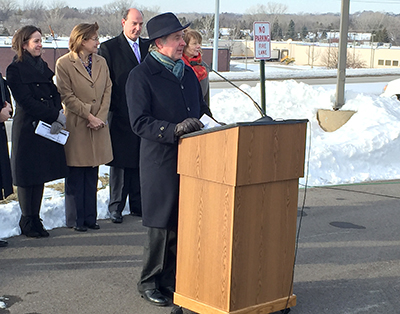
Commissioner Charlie Zelle discusses the TED program Tuesday during a news conference to announce the construction projects that were selected under the program. Behind Zelle are (from left) Sen. Melisa Franzen, Sen. Melissa Wiklund, Rep. Paul Rosenthal and Lt. Governor Tina Smith. Photo by Kevin Gutknecht |
Funding for 11 state highway projects throughout the state was awarded Tuesday by the Minnesota Department of Transportation and the Department of Employment and Economic Development.
Grants totaling $32 million will support growing industry and businesses, leverage private funding and improve the transportation system for all users. The funding was awarded under the state’s Transportation Economic Development Program. Maps show the location of the projects and provide a brief description of the work in Greater Minnesota and the Twin Cities metro area.
“Transportation investments support jobs, create vibrant communities and position businesses for the global economy,” said MnDOT Commissioner Charles Zelle. “MnDOT’s partnership with DEED and with the business community through the TED program has seen great results in promoting economic development all across the state.”
MnDOT and DEED have provided nearly $77 million in grants to 28 communities through the TED program since 2011. Program criteria emphasize improvements that enhance the statewide transportation network, including all modes and all jurisdictional systems, and improvements that allow existing businesses to expand or new businesses to locate near the project area. The TED program also has leveraged more than $119 million from public and private partners that derive a direct benefit from the improvement.
The $32 million provided this year in state TED funds will help leverage other federal, state, local, and private funding for a total construction program of $137 million. State funding for the program comes from trunk highway dollars ($29.7 million) and DEED General Obligation Bonds ($2.3 million).
“For every public dollar we invest, the program leverages an additional three dollars in economic development investment,” said Lt. Governor Tina Smith. “These are great projects, but they don't come close to meeting our need for a sustainable, comprehensive solution to Minnesota's transportation challenges. If we want to grow jobs and our economy, we need a statewide transportation system that works everywhere, for Minnesotans and Minnesota businesses.”
MnDOT and DEED received 22 project proposals to its 2015 solicitation. Eleven proposals came from the Twin Cities metro area and 11 from Greater Minnesota, requesting a total of more than $76 million in funding. Project selection was based on consistency with transportation plans, economic benefits, project financing and project readiness.
It’s estimated that the recommended projects will create more than 5,900 jobs in the next five years.
All recommended Twin Cities Metro Area projects also received federal funds under the Metropolitan Council Regional Solicitation Process. TED dollars are generally the last piece of funding needed to move each of the recommended projects toward letting.
Construction lettings are scheduled between 2016 and 2018. |
 |
|

|
 |
TABLE of CONTENTS
 |
Growing Our Own heavy equipment mechanics across districts |
By Jerimiah Moerke, District 4 public affairs coordinator
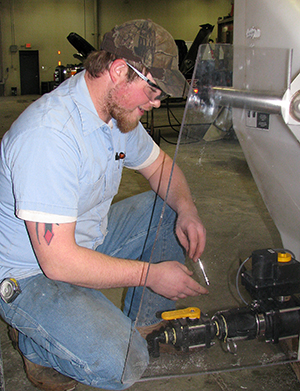
Trevor Kent, District 4, works on equipment in the Detroit Lakes shop. Trent is a Grow Your Own trainee in District 4. Photo by Jerimiah Moerke |
Shops around MnDOT are trying a new approach to training and hiring mechanics. The name of the program—GOO—sounds a little messy, but the intent falls right within MnDOT’s mission.
The idea for the Grow Our Own program was launched about four years ago by looking at a map of potential retirements of heavy equipment mechanics across the state. It was obvious that several vacancies would need to be filled over the coming years, but it’s become more and more difficult to fill skilled trade positions.
A group of shop supervisors set out to solve the problem-- and expand the diversity of the shop workforce.
GOO candidates must have some mechanical experience and show aptitude for the profession. They are hired as heavy equipment service attendants, work with existing shop mechanics and attend training to learn the skills needed to meet the qualifications for the heavy equipment mechanic position.
The program lasts for up to four years for each candidate.
Since the program’s launch in 2012, two GOO trainees, Nick Daronco, District 1, and Tony Smith, District 7, were hired on as heavy equipment mechanics. MnDOT currently employees three GOO trainees-- Trevor Kent, District 4, Mat Russell, Metro District and Tom Schtzlein, Central Shop. In addition, there are two vacant positions.
Kent was one of the first GOO trainees hired. He works closely with the shop supervisors and mechanics in Detroit Lakes.
“If I don’t know something, I can go and ask any of the other mechanics,” Kent said.
Having Kent on board has also had an additional unexpected advantage. He went to school for power sports, which involves small engine work. Even though that’s a small part of the work in the MnDOT shop, he’s able to share his knowledge with his colleagues.
“It works both ways. Even though his training was not in heavy mechanics, it turned out to be beneficial,” said Charles Charboneau, shop supervisor in Detroit Lakes. “Trevor’s been able to help others repair small engines in some of our bridge equipment.”
Schatzlein is the newest GOO trainee. He spent three years as a mechanic at a used car dealership, but didn’t have the necessary background with heavy equipment and hydraulics for a heavy equipment mechanic position.
“I have experience, but I don’t have the schooling, so it was a good way for me to get in and learn what MnDOT does in its vehicles and how plows are built,” Schatzlein said.
The GOO program is currently funded through the central road equipment budget. During their training period, trainees are allowed to use MnDOT-provided hand tools. An annual budget of $300,000 for the program covers salaries, benefits and training for the candidates. |
 |
|

|
 |
TABLE of CONTENTS
 |
MnDOT vehicles get Toward Zero Deaths decal |
|
By Sue Roe
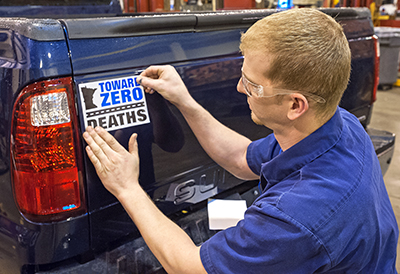
Joe Musolf, heavy equipment mechanic at Central Shop, places a TZD decal on a MnDOT truck. As vehicles are brought in for maintenance or new vehicles purchased, district shops will place the decals on all on-road units. Photo by David Gonzalez |
All MnDOT on-road vehicles are getting the Toward Zero Deaths decal placed on them as a show of support to reduce traffic-related deaths and severe injuries.
Decals were ordered and distributed throughout the districts, according to Robert Ellingsworth, fleet manager. They will be placed on the vehicles when they come in for maintenance at all state maintenance shops. This includes new and current fleet vehicles, trucks and snowplows. MnDOT has 3,275 on-road units.
The decals will be positioned on the rear driver’s side so they can be seen by occupants of vehicles behind the MnDOT vehicle.
Two TZD statewide community partners, North Memorial Health Care and Safeway Driving School, added the decal to their vehicles in September. At North Memorial, a Level I trauma center, decals were placed on 275 vehicles and nine helicopters. At Safeway, a Twin Cities driving school, 32 vehicles have decals.
A few years ago, a Cemstone ready mix truck in Owatonna was one of the first private company vehicles to use the TZD decal.
Kristine Hernandez, TZD state coordinator, began talking at the TZD regional workshops about changing the culture of reducing traffic-related deaths and injuries. Agency staff, and personnel from enforcement, education, engineering, emergency medical and trauma services attend the annual training.
Hernandez said when TZD was launched in 2003 by MnDOT and the state departments of public safety and health. Leadership of those agencies realized that moving toward a zero deaths goal would require cooperation among state agencies and local organizations, including private partnerships.
By spreading this public awareness, these partnerships are helping to create a culture where these deaths and injuries are no longer acceptable, she said.
“Displaying the logo is a way to show commitment to the TZD goal,” Hernandez said.
She is working with other counties and cities to put decals on their vehicles. |
 |
|

|
 |
TABLE of CONTENTS
 |
Training opportunities, other employees help participants expand their knowledge in Leadership Development Program |
By Rich Kemp

Adrienne Hedlund, District 1 training and development, listens as Ben Worel, MnROAD operations engineer, explains some of the road surfaces they are researching at MnROAD. Hedlund was attending training at MnROAD as part of the Leadership Development Program. Photo by Rich Kemp |
MnDOT is dedicated to providing an environment for all employees to be successful. The Leadership Development Program is offered as a way to improve employees’ core competency skills and to learn more about MnDOT. The program is customized and flexible to meet each participant's development goals. It can be structured or informal, rigorous, ongoing or flexible all at the same time.
There are 185 employees currently entered in the program, with 96 employees in Group 4, which ends in January and 89 in Group 5, which ends in July. Enrollment for Group 6 is open until Jan. 15 and the program starts March 1.
Matt Indihar, District 3 Grad 2 engineer, completed the program in July 2015.
“It was a great learning experience,” said Indihar. “I was able to attend several classes pertaining to the goals established in the program. It really helped me to expand on my leadership abilities and to become more effective in my position.”
“I have been pleased with this program and have learned and gained so much,” said Susan Larson, Metro District accounting director.
The program allows employees to have complete control of their development by setting and pursuing their own goals.
“I really like the program, mainly because it gives people an opportunity to develop themselves and then learn more about MnDOT as a whole,” said Adrienne Hedlund, District 1 training and development.
The program offers employees the chance to build relationships and networks. In addition to the training provided, participants meet and learn from other employees in the program who offer different perspectives, experiences and expertise.
“One of the best parts of the program for me was the networking ability,” said Indihar. “You really got to work with a wide range of people within MnDOT in these classes. I was used to seeing the same functional groups at required trainings or conferences. In the LDP classes, there were always new people from all over MnDOT and this gave me a different perspective and fresh, new ideas.”
“It is a great opportunity to meet new people, get your name out there and learn more about MnDOT so you know what avenues are out there,” said Hedlund.
Shawn Meade, LDP training coordinator, said about 18 percent of the program’s participants have participated in the program more than once. Professional development can be a continuous journey.
“In the beginning, I was able to attend sessions that helped me visit different areas of MnDOT that I would not have been able to see in my normal daily routine such as airports, MnPASS offices, the Regional Transportation Management Center, the MnROAD facility, the construction of a major bridge project, and many more,” said Larson, who has participated in several LDP sessions. “Since then I have taken advantage of training opportunities to help me as a co-worker and a supervisor with classes that aid in your success as a MnDOT employee and as a leader.”
Employees don’t have to be a supervisor or manager to participate in the program. Some employees may be just beginning their leadership journey while others are already in a leadership role in a more formal capacity.
The program requires participants to create their own development goals and set their own schedule to complete their goals to fit into their busy work schedule.
“The program definitely enhanced my ability as a leader,” said Indihar. “In working towards my goals, I developed a whole new set of tools to apply to any scenario that may come up in my work. “
For more information and enroll in the program, check out the LDP website or contact Carol Hennekens, Shawn Meade or Amanda Klawiter. |
 |
|

|
 |
TABLE of CONTENTS
 |
Employees pay it forward during the holidays, throughout the year |
|
By Judy Jacobs

Lucky winners of handmade quilts from the District 4 Hospice fundraiser were (from left) Bruce Bryngelson, Bri Raftevold and Lyle Steichen. Photo by Jerimiah Moerke |
Employees around the state participated in a variety of activities to give back to their local communities, donating toys, food, money and handmade gifts to those in need.
“It just shows the generous nature of our MnDOT employees,” said Tracy Hatch, deputy commissioner, chief financial officer and chief operating officer. “Not only do our employees have an impact in their local communities by the work they do, but they also go above and beyond by reaching out and supporting local people in need.”
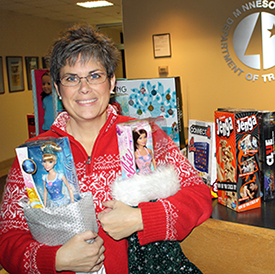
Cindy Yost, District 1 Business Office, shows some of the toys that were donated in District 1. Photo by Beth Petrowske |
Here’s a look at some of the efforts around the state:
District 1
District 1 employees donated 67 toys for Toys for Tots this year. Cindy Yost, District 1 Business Office, coordinated the project. “Most of the toys we received were for younger children,” said Yost. “Next year we hope to get some gifts for the older kids and teens, too.”
District 2
Employees in District 2 raised money for an employee’s family in need. Employees purchased white snowflakes with a baby blue center to hang on the Family Giving Tree, located at the Bemidji headquarters office.
Each snowflake, purchased as a good will donation from employees, was used to help with medical expenses for baby Liam, grandson of Carol Dudgeon, District 2 human resources technician. Liam was born 15 weeks premature, weighing only 1 lb. 14 oz.
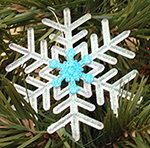
These snowflake ornaments were purchased by District 2 employees to help raise funds for baby Liam. Photo by TJ Melcher |
He spent three months in the Neonatal Intensive Care Unit in Grand Forks. He has been hospitalized twice in recent weeks at Minneapolis Children’s Hospital, which put a strain on the young family because of massive medical bills and travel expenses.
In addition to the Family Giving Tree, employees in the Bemidji headquarters building gathered for a holiday potluck and silent auction with all proceeds going to Liam and his family. The total amount collected during this year’s fundraiser was $1,266.
District 3
St. Cloud area employees raised $1,651 and 63 toys for the area Toys for Tots program. AFSCME Local 604 donated $300. At a recent blood drive held in St. Cloud employees donated 14 units.

Sarah Dragt, District 3 Administrative Support, presents the fundraiser proceeds to a Toys for Tots representative. Photo by Michelle Pooler |
Baxter area employees raised $755 and about 80 toys for the Brainerd Lakes Areas Toys for Kids. AFSCME Local 588 donated $300. In November, Baxter employees held a blood drive and collected 27 pints of blood.
District 4
Since 1995, District 4 employees have held an annual fundraiser to help Hospice of the Red River Valley. Employees and retirees donate all of the items for the drawing, many of them handmade. This year’s event raised $2,330 for Hospice, with a grand total of contributions of $26,845 over the past 20 years.
District 6
District 6 employees donated to the local Toys for Tots drive. Donations filled the bins multiple times at three drop-off sites: Rochester, Owatonna and Winona. District employees have been involved with the program for 13 years; often, donations come from visitors as well as MnDOT employees.
In addition, 13 employees participated in the Polar Plunge for Special Olympics and raised $3,707. The temperature was one degree and the wind chill was -16 the day of the event.
The district also sponsors blood drives on a regular basis.
District 7
AFSCME Local 280 collected donations for the Echo Food Shelf during a potluck. Combined donations totaled 110 pounds of food and $55 in cash. Employees also joined the State Patrol Dispatch 2200 in the local Toys for Tots campaign.
In August, district employees held the 5th annual "I Like Mike" fundraiser in memory of Mike Struck. Struck was a District 7 employee from the Mankato Truck Station who lost his life battling the floods in 2011.
All proceeds from the fundraiser benefited Struck’s children, Kaylee and Gavin, the Darryl Jansma family, fire Departments in St. Peter, Cleveland and Kasota, with additional funds going to an account for a future worker memorial in District 7.
Central Office
A total of 54 boxes of clothing and food were donated by Central Office employees. Several charities benefited from the drive, including Second Harvest Heartland, The Family Place homeless shelter and The Listening House homeless shelter. Women’s and children’s clothing were donated to the Women of Nations emergency shelter and the Minneapolis American Indian Center.
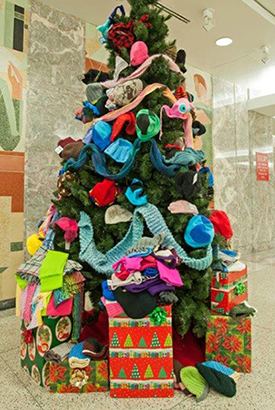
Central Office employees decorated the lobby tree with donated warm clothes for area children. Photo by David Gonzalez |
A large Christmas tree in the lobby gave employees an opportunity to decorate it with hats, scarves and mittens for children in need.
Monetary donations totaling $1,097 were given to the Listening House and Second Harvest Heartland.
In addition, the Fall 2015 Manager’s Workshop participants donated clothing and money for the Women of Nations emergency shelter.
"Many charities benefited from this clothing, food and fund drive," said Nancy Stone. "The charities we helped were so grateful for all of these much-needed supplies and money."
Central Office held its latest blood drive Dec. 21 and employees donated 31 units of blood.
Metro District
Metro does two to three blood drives each year with an average of 35-40 employee donating to this worthy cause.
Bridge Office
The Bridge Office divided into four teams and competed to collect the most items for Sharing and Caring Hands. Donations of food, clothing, household items, toys, personal hygiene items, money -- and even vehicles -- were requested since the winner of this competition was determined by the weight of the donations they collected. In addition, employees donated items for a silent auction with all proceeds from the auction also going to Sharing and Caring Hands.
Bridge employees donated 1,165 pounds of donated items, plus $1,362 in cash this year.
Bridge employees also stepped up for a blood drive held in November and had 18 employees donate 18 units!

Ashley Grzybowski, Bridge Office, helped prepare nearly 1,200 pounds of donated items for Sharing and Caring Hands. Photo by Lisa Gaughan |
|
|
|
 |
|

|
 |
TABLE of CONTENTS
 |
MnSAFE receives Innovations in State Government award |
By Rich Kemp
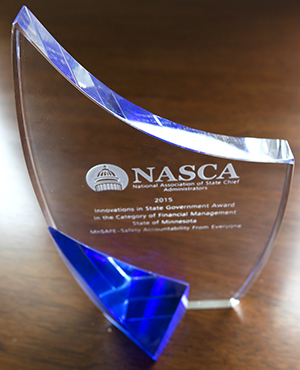
MnSAFE received the Innovations in State Government award from the National Association of State Chief Administrators. Photo courtesy of MnSAFE |
The State of Minnesota’s efforts to reduce employee injuries recently received national recognition. The National Association of State Chief Administrators named Minnesota’s MnSAFE initiative as one of the inaugural winners of its Innovations in State Government Awards.
MnSAFE, which stands for Safety Accountability from Everyone, was established in 2011 with the signing of Gov. Mark Dayton’s Commitment to Workplace Safety. The initiative set out to reduce the rate of injuries to state employees by 25 percent over three years. Through proactive measurement and targeted prevention efforts, the state reduced the injury rate by about 23 percent and prevented nearly 900 injuries!
Based on that success, the governor recently renewed the effort for four more years.
“The implementation of MnSAFE encouraged the agency to involve more employees at all levels, creating greater safety awareness throughout the agency, ultimately improving our safety culture,” said Julie Libonate, MnDOT acting safety director.
As part of the program, MnDOT is committed to creating a safe and healthy workplace. From 2011 to 2014, the agency saw a 19 percent reduction of accepted workers compensation claims. There was also an increase in employees/work groups meeting the criteria of the safety recognition program implemented in 2013.
“The success of MnSAFE and the recent award from NASCA wouldn’t have been possible without the contributions of all employees across state government,” said Todd Christenson, Department of Administration. “The MnSAFE team at the Department of Administration thanks you for all you do to create a safe workplace.”
Learn more about the award on NASCA’s website and keep up with the MnSAFE initiative at mn.gov/mnsafe. |
 |
|

|
 |
TABLE of CONTENTS
 |
Whatís new on the web |
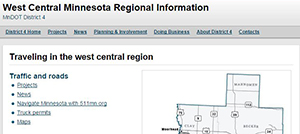
The District 4 website has a new look. |
New and improved District 4 site
You may have noticed the District 4 website is now mobile-optimized and accessible. Information is much easier to find at a glance, and navigation is consistent throughout the site. Look over the pages to get a feel for the new format!
Check out the updates on the website.
|
 |
|

|
 |
TABLE of CONTENTS
 |
On the Job: Mike Dougherty enjoys telling MnDOTís story as a district public affairs coordinator |
By Judy Jacobs
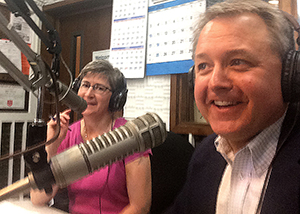
Mike Dougherty, District 6 public affairs coordinator, and Nancy Klema, District 6 traffic operations engineer, talk on KROC AM. Dougherty brings MnDOT guests for the monthly hour-long talk show in Rochester. Photo courtesy of District 6 |
Mike Dougherty, District 6 public affairs coordinator, rarely has a dull moment. His day is filled with a wide range of activities that keep him busy—from watching crews band peregrine falcons to meeting with local businesses to interviewing with local media. There is no such thing as a typical day for a district PAC.
During the months of snow and ice, MnDOT Mike, (as the District 6 media named him) is ready to get ahead of the weather reports and tell MnDOT’s story as crews prepare for winter storms. Typically you’ll see Dougherty talking to reporters about local road conditions and asking motorists to slow down and drive safely before, during and after the plows are out on the road. Working closely with maintenance personnel is an important part of a PAC’s job.
Building strong working relationships with the public is, too. PACs often act as ambassadors of commerce for their respective districts, meeting with government officials, business owners, chamber of commerce members, media and local residents as well a variety of internal MnDOT offices and departments.
PACs are also sought after spokespeople for their districts. View Dougherty explaining how MnDOT employees take advantage of the warm winter weather at http://www.kaaltv.com/article/stories/s3988829.shtml. He also hosts a monthly talk show at local radio station KROC AM which allows him to bring in other MnDOT guests to talk about issues affecting the district. To hear a recent interview with KROC visit krocam.com/mndots-mike-dougherty-on-rochester-today/.
“Mike brings a lot of energy and excitement into his job,” notes District 6 District Engineer Jeff Vlaminck. “He is genuinely interested in what we do and loves to tell our story and it shows. Mike does an outstanding job establishing and maintaining relationships with key media contacts, which enables him to be a trusted resource in representing the department.”
“In addition,” Vlaminck continues, “he does an excellent job responding to complaints and inquiries - adding a personal touch. He is able to turn an angry customer into a strong MnDOT advocate with honest plain language answers and a personal touch. I feel Mike is an invaluable resource to me, and our project managers, assisting in communication plans and key messages – translating our technical engineering terms into something the public can understand.”
If there’s a story that needs to be told in District 6 you can be sure that MnDOT Mike is on the job.
How would you describe a district public affair coordinator's job?
You need to know a little about a lot. We don’t belong to a large department, so you have to know nearly everyone, because they might have the answer or information that you need. I tell people that I might not know the answer, but I know a lot of smart people who can get the answer.
Has your job changed much since you started in District 6 two years ago?
It hasn’t changed greatly. I’ve only been here since January 2014. We still follow the seasons of construction and snow and ice, and we still get prepped for it in advance. At the core of the job is telling stories. We have different ways to tell those stories, such as a news release, talking with the media, social media or an employee newsletter. Some of those tools change or take on a greater emphasis, but I find the most effective communication about MnDOT’s work and learning about what others thinks is through face-to-face communication and building relationships that way.
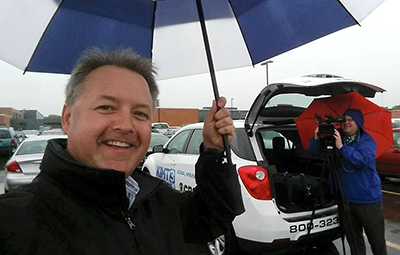
Mike Dougherty, District 6 public affairs coordinator, and Adam Sallet, KIMT-TV, prepare for an interview in the rain. Photo courtesy of District 6 |
What has been the best part of your career at MnDOT?
The people. In our job, we meet a diverse group of people from the governor and commissioner to the attendant in the rest area. I love it, because everyone has a story and I often walk away having learned something new. Our folks here at MnDOT who have some role in planning, designing, building bridges and roads and just making this organization run are some of the most interesting, smart people I’ve known. The cool thing is that the people at MnDOT just see their work as their skill and something they do even though so much of the work is amazing stuff that most of us could never even fathom doing. What I like most is that I get to learn. The people I’ve met on my job always have time to explain things, which helps me do my job that much better.
What was your most unique experience?
Standing on a Wabasha Bridge pier on Hwy 60 over the Mississippi River and watching people take blood samples and band peregrine falcon chicks that had hatched in a nesting box MnDOT had placed under the bridge for the birds. The effort helps encourage the growth of the species and is a natural way to keep pigeons away from the bridge. Our bridge maintenance people worked with the group and let me tag along to help with media and the story.
What are some of the challenges of the job?
Finding time to tell the stories. There’s just one of me in District 6, but there are countless good stories to tell. We focus on providing good information to the public about the roads, the conditions and why we do what we do. There are times when I wish there was more time in the work week. I know my counterparts in the other districts run into the same dilemma, but we still manage to cover a lot of ground in a day and connect with a lot of people.
What are some of the positives, or exciting parts, of your job?
The best part of my job is the variety. In the course of a week I can be talking with a TV station at 6:30 one morning, doing a live call-in radio show for an hour, helping coordinate a roundtable for the commissioner in Rochester, visiting two Mississippi River bridge construction sites, meeting with citizens or local officials, responding to the public’s questions or complaints and helping coordinate communication for the stringing of a power line along Hwy 52 where helicopters are used. I love to learn and I get that chance about 10 times each day.
What’s the most important part of being a district PAC?
Helping people understand what MnDOT does. I view myself as sort of a typical person. A John Q. Public, if you will. We like to know what’s going on, why and when. As public affairs coordinators we have this wonderful license to learn what’s going on in every department and to connect with the public. We can be talking about work zone safety with a truck driving school or working with a local chamber of commerce or planning how to connect with people about an upcoming construction project that will disrupt the normal traffic flow. It can help the organization and really help us build good, strong partnerships within the communities where these projects are located. People are often anxious about construction, but I’ve often found that once they have the information they’re more likely to work with us to find a good way to lessen the impact and help people make good driving decisions.
Our work also helps the public understand the professionalism and skill behind the people at MnDOT that goes into building their roads and bridges. These project costs are in dollar figures that most of us are not familiar with, but once we talk about how it works and the type of care our inspectors and materials lab puts into ensuring it’s done well, they usually feel good about the project. Sometimes they become our advocates with others.
What did you do before you came to MnDOT?
I was a journalist for nearly 25 years. I’ve been a reporter and editor at a daily newspaper, as well as a freelance writer. The deadline is my friend.
If you could, what one thing would you change about your job?
I’d get a teleporter so I could zip around to more places faster, but I don’t think that’s in the budget. Actually, my job’s pretty good. I’ve got lots to do, but I like doing it and I like the people I work with. They’re smart and many have a great sense of humor, which provides me with a good passel of daily chuckles.
For a list of statewide PACs and media contacts visit http://www.dot.state.mn.us/mediaroom/mediacontacts.html |
 |
|

|
 |
TABLE of CONTENTS
 |
2015 social media by the numbers |
By Bob Filipczak
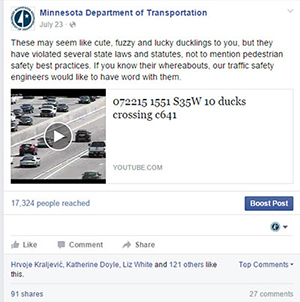
This video posted on the MnDOT YouTube page in July received more than 120 likes and 90 shares. |
At the risk of sounding like the State of the Union address, the status of MnDOT’s social media at the end of 2015 is strong. We hit a couple of milestones this year, the biggest being crossing the one million views mark on our YouTube channel in August.
We reached another milestone right before the end of the year when we hit 20,000 followers for our Twitter account--Mndotnews.
It’s important to remember that Facebook has its own jargon to describe its numbers:
- Reach is the number of unique individuals who saw our post on their news feed on Facebook. Our reach was 1.18 million in 2015.
- Impressions are the number of times our post was displayed on someone’s news feed. Our impressions were 2.2 million in 2015.
Finally, this was the year we took on the real estate market and the talent acquisition industry. On weekends we are using Facebook and Twitter to advertise job openings and excess property that MnDOT owns. |
 |
|

|
|
| |
|



